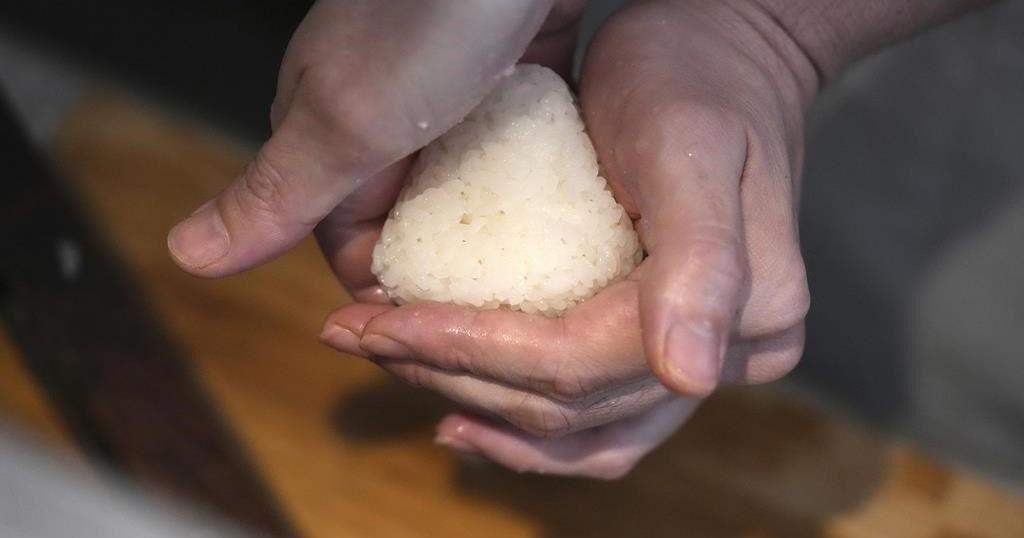TOKYO (AP) — The word “onigiri” became part of the Oxford English Dictionary this year, proof that the humble sticky-rice ball and mainstay of Japanese food has entered the global lexicon.
The rice balls are stuffed with a variety of fillings and typically wrapped in seaweed. It’s an everyday dish that epitomizes “washoku” — the traditional Japanese cuisine that was designated a UNESCO Intangible Cultural Heritage a decade ago.
Onigiri is “fast food, slow food and soul food,” says Yusuke Nakamura, who heads the Onigiri Society, a trade group in Tokyo.
Fast because you can find it even at convenience stores. Slow because it uses ingredients from the sea and mountains, he said. And soul food because it’s often made and consumed among family and friends. No tools are needed, just gently cupped hands.
“It’s also mobile, food on the move,” he said.
Onigiri in its earliest form is believed to go back at least as far as the early 11th Century; it’s mentioned in Murasaki Shikibu’s “The Tale of Genji.” It appears in Akira Kurosawa’s classic 1954 film “Seven Samurai” as the ultimate gift of gratitude from the farmers.
What exactly goes into onigiri?
The sticky characteristic of Japanese rice is key.
What’s placed inside is called “gu,” or filling. A perennial favorite is umeboshi, or salted plum. Or perhaps mentaiko, which is hot, spicy roe. But in principle, anything can be placed inside onigiri, even sausages or cheese.
Then the ball is wrapped with seaweed. Even one nice big onigiri would make a meal, although many people would eat more.
Some stand by the classic onigiri
Yosuke Miura runs Onigiri Asakusa Yadoroku, a restaurant founded in 1954 by his grandmother. Yadoroku, which roughly translates to “good-for-nothing,” is named for her husband, Miura’s grandfather. It claims to be the oldest onigiri restaurant in Tokyo.
There are just two tables. The counter has eight chairs. Takeout is an option, but you still have to stand in line.
“Nobody dislikes onigiri,” said Miura, smiling behind a wooden counter. In a display case before him are bowls of gu, including salmon, shrimp and miso-flavored ginger. “It’s nothing special basically. Every Japanese has 100% eaten it.”
Also a classical flautist, Miura sees onigiri as a score handed down from his grandmother, one which he will reproduce faithfully.
“In classical music, you play what’s written on the music sheet. Onigiri is the same,” he says. “You don’t try to do something new.”
Yadoruku is tucked away in the quaint old part of Tokyo called Asakusa. It opens at 11:30 a.m. and closes when it runs out of rice, usually within the hour. Then it opens again for dinner. The most expensive onigiri costs 770 yen ($4.90), with salmon roe, while the cheapest is 319 yen ($2). That includes miso soup. No reservations are taken.
Although onigiri can be round or square, animal or star-shaped, Miura’s standard is the triangular ones. He makes them to order, right before your eyes, taking just 30 seconds for each.
He places the hot rice in triangular molds that look like cookie cutters, rubs salt on his hands and then cups the rice — three times to gently firm the sides. The crisp nori, or seaweed, is wrapped like a kerchief around the rice, with one end up so it stays crunchy.
The first bite is just nori and rice. The gu comes with your second bite.
“The Yadoroku onigiri will not change until the end of Earth,” Miura said with a grin.
Others want to experiment
Miyuki Kawarada runs Taro Tokyo Onigiri, which has four outlets in Japan. She is eyeing Los Angeles, too, and then Paris. Her vision: to make onigiri “the world’s fast food.”
The name Taro was chosen because it’s common, the Japanese equivalent of John or Michael. Onigiri, she says, has mass appeal because it’s simple to make, is gluten-free and is versatile.
And other Japanese foods like ramen and sushi have found worldwide popularity, she notes.
At her cheerful, modern shop, workers wearing khaki-colored company T-shirts busily prepare the gu and rice balls in a kitchen visible behind the cash register. The shop only serves takeout.
Kawarada’s onigiri has lots of gu on top, for colorful toppings, instead of inside. Each one comes with a separately wrapped piece of nori to be placed around it right before you eat.
Her gu gets adventurous. Cream cheese is mixed with a pungent Japanese pickle called “iburigakko,” for instance, and each onigiri costs 250 yen ($1.60). Spam and egg onigiri costs 300 yen ($1.90); the one adorned with several types of “kombu,” or edible kelp, called “Dashi Punch X3,” costs 280 yen ($1.80).
“Onigiri is the infinite universe. We don’t get tied down in tradition,” said Kawarada.
The customers
Asami Hirano, who stopped in while walking her dog, took a long time choosing her meal at Taro Tokyo Onigiri on a recent day.
“I’ve always loved onigiri since I was a kid. My mother made them,” she said.
Nicolas Foo Cheung, a Frenchman who works nearby as an intern, had been to Taro Tokyo Onigiri a few times before and thinks it’s a good deal. “It’s simple food,” he said.
Miki Yamada, a food promoter, intentionally calls onigiri “omusubi,” the other common word for rice balls, because the latter more clearly refers to the idea of connections. She says her life’s mission is to bring people together, especially since the triple earthquake, tsunami and nuclear disasters hit her family’s rice farm in Fukushima, northeastern Japan, in 2011.
“By facing up to omusubi, I have encountered a spirituality, a basic Japanese-ness of sorts,” she said.
There is nothing better, she said, than plain Aizu rice omusubi with a pinch of salt and utterly nothing inside.
“It energizes you. It’s that ultimate comfort food,” she said.
__
Yuri Kageyama is on X:






















